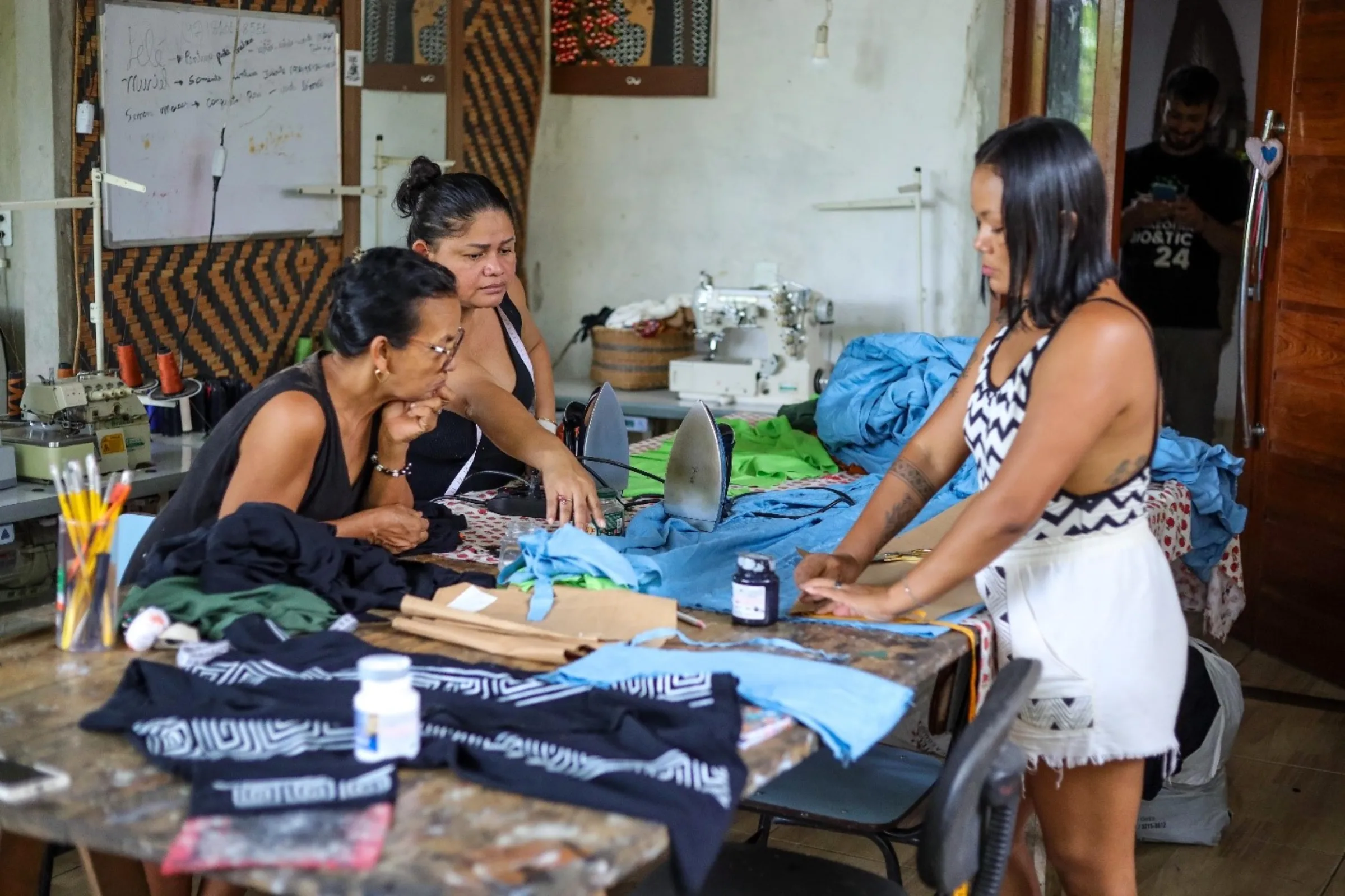Context is powered by the Thomson Reuters Foundation Newsroom.
Our Standards: Thomson Reuters Trust Principles

Leia Witoto, Gleice Mura and Lecia Witoto make clothes in Ateliê Derequine’s headquarters in Manaus, Brazil, March 12, 2025. Nathalie Brasil/Thomson Reuters Foundation
Around the world, the Indigenous movement is creating its own funds to manage climate and nature financing.
RIO DE JANEIRO - Labouring in a workshop near Brazil's rainforest, a group of women snips, sews and paints fabric with traditional patterns for their fashion collective, using industrial machines bought with money from the first Amazon community fund fully run by Indigenous people.
The Ateliê Derequine Indigenous fashion collective, founded in 2020 to produce masks against COVID-19, dresses models and takes part in runway shows in Brazil's industrial metropolis of Manaus, providing jobs and a platform for Indigenous rights campaigns.
"We bring politics to runways, where we've raised banners for demarcation" to denote and recognise Indigenous territories, said Vanda Witoto, who is responsible for mobilising Ateliê Derequine.
The collective's growth was enabled by a 50,000-reais ($8,600) grant in 2023 from the Indigenous Fund of the Brazilian Amazon, or Podáali, the first Amazon rainforest fund fully run by Indigenous people.
In the Baniwa language, Podáali means to give without expecting anything in return.
Ateliê Derequine would have struggled without the Podáali fund, according to Witoto.
Conventional finance institutions "just want (Indigenous people) to plant trees," she said.
"They don't care about our actual lives. We go to international events, and there is no interest in talking to us," she added.
The fashion collective utilises Indigenous networks reaching deep into the Amazon, where communities provide seeds for buttons and clothing fasteners.
Its designs, in turn, attract support well beyond the Indigenous community, according to organisers and Podáali.
The Podáali fund, launched in 2019 by the Coordination of Indigenous Organizations of the Brazilian Amazon (Coiab), is one of a rising number of finance institutions led by political bodies from Indigenous and other local communities.
The movement has been gaining traction since 2021, when environmental NGO Rainforest Foundation Norway published a report showing in the previous decade, only 1% of global funding for climate mitigation and adaptation had been directed to those populations.
At the U.N. COP26 climate talks in Glasgow that year, wealthy countries and charities pledged to step up funding to Indigenous people and others with land rights over natural areas.
According to data from the Rights and Resources Initiative, a global land rights coalition, $2.22 billion was disbursed to these communities to protect and manage land between 2021 and 2024 - 38% more than in the previous four years but still a small sum compared with total global investments.
"There are entities that ... do not want to break with colonialist" postures, sidelining investments in Indigenous and other local communities, said Juan Carlos Jintiach, executive secretary to the Global Alliance of Territorial Communities (GATC).
Much of climate and biodiversity investment managed from abroad is spent on bureaucracy before reaching local communities, he said.
A report last year by the Forest Tenure Funders Group, a coalition of wealthy countries and philanthropies that pledged to direct $1.7 billion to communities by 2025, concluded only 10.6% of the money its members disbursed in 2023 was directly managed by communities.
By creating its own funds, the Indigenous movement aims to take more direct control and distribute money to local priorities, with simpler bureaucracy, according to a 2023 report by Shandia, a platform launched by GATC.
Podáali is part of a network of nine funds from Brazil's Amazon communities, which also include "quilombola" descendants from enslaved Africans and other groups that rely on the forest.
The region is leading the way in the establishment of these finance mechanisms, mostly managed by women, said Aurelio Vianna, a programme officer with international NGO Tenure Facility, which helps structure community funds and is one of Podáali's funders.
The funds are being driven by Indigenous leadership "in spite of enormous global backlash" against nature-focused policies such as the U.S. government's cutting of global climate projects, Vianna said.
Podáali's headquarters sits in an office building downtown, away from tourist areas. All the building's windows and inner office doors are reinforced with metal grids for security.
Rose Meire Apurinã, Podáali's deputy director, said funding decisions are based on simple questionnaires to ease up on bureaucratic obstacles and snarls.
Instead of a top-down approach prescribing the types of initiatives communities should focus on, the fund wants to "strengthen what is already being done," she said.
In 2023 and 2024, Podáali granted between 20,000 reais ($3,500) and 50,000 reais ($8,800) to some 77 initiatives.
The money was used, in part, to buy drones for forest surveillance and to fund protests against anti-environmental bills in the capital city of Brasilia.
Last year, Podáali raised 9 million reais ($1.6 million), mostly with international partners such as the U.S.-based Wellspring Philanthropic Fund, Christensen Fund and Nia Tero Foundation.
With Podáali's help, Brazil's Indigenous movement is seeking to expand such funds outside the Amazon.
At last year's Climate Week in New York, Apib, Brazil's largest Indigenous umbrella organisation, launched a new fund called Jaguatá, structured with Podáali's support.
Apib Coordinator Dinamam Tuxá said financiers have been prioritising the iconic Amazon over lesser known natural areas such as the Cerrado savannah, listed as Brazil's most deforested biome in 2024 by the National Institute for Space Research.
Jaguatá aims to overcome this gap.
"Our challenge is to make it visible that all biomes are connected," Dinamam said.
(Reporting by Andre Cabette Fabio; Editing by Jack Graham and Ellen Wulfhorst.)
Context is powered by the Thomson Reuters Foundation Newsroom.
Our Standards: Thomson Reuters Trust Principles